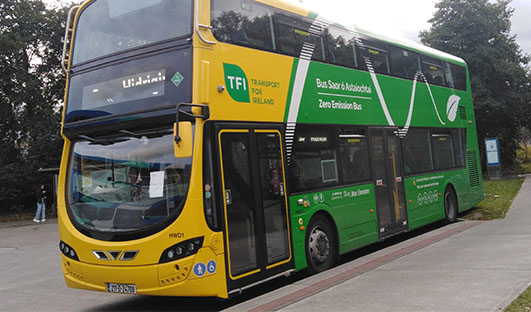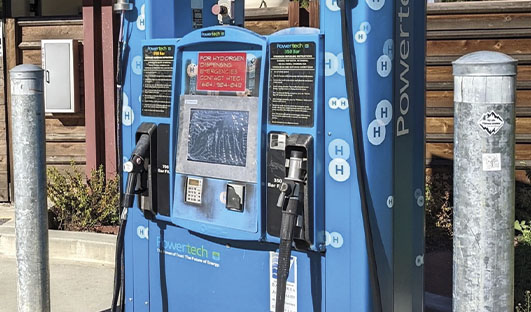Hydrogen and transport

The potential of hydrogen in fuelling transport is well known, but widespread uptake of hydrogen fuel cell vehicles is still a decade away.
Transport emissions make up 27 per cent of total greenhouse gas emissions in the European Union and accounted for 17.9 per cent in 2020 in Ireland, although this figure was impacted by Covid-19 and was recorded at 20.4 per cent in 2019. Moreover, in 2018, the sector accounted for 40 per cent of energy related CO2 emitted.
The European Sustainable and Smart Mobility Strategy, signed into European law by the European Commission in December 2020, aims to decarbonise the transport sector, with the first aim of having 30 million zero-emission vehicles on European roads by 2030. Full carbon neutrality is aimed at for 2050. Hydrogen is set to play a key role in this transition, with the communication from the Commission on the strategy stating: “Manufacturers are also investing into hydrogen fuel-cell vehicles, particularly for use in commercial fleets, buses and heavy duty transport. These promising options are supported under the EU energy system integration and hydrogen strategies as well as the strategic action plan on batteries… Rail transport will also need to be further electrified; wherever this is not viable, the use of hydrogen should be increased.”
Hydrogen is used to power fuel cells, the most common of which used in vehicles is the polymer electrolyte membrane fuel cell. The membrane is used to separate oxygen and hydrogen within the fuel cell, with the oxygen collected by the positively charged cathode and the hydrogen collected by the negatively charged anode. Hydrogen molecules break into protons and electrons via an electrochemical reaction, with the positively charged protons traveling to the cathode and the negatively charged electrons to an external circuit, providing power to the battery and propelling a battery-powered vehicle. This method produces no exhaust emissions.
Hydrogen fuel cells are capable of powering all modes of road transport, from personal cars to HGVs, trains, ships and airplanes. Hydrogen fuel cells have been found to be more efficient than typical petrol or diesel combustion engines, with 60 per cent efficiency topping 25 per cent for the latter; however, both are bested by the 80 per cent efficiency of pure electric vehicles. This efficiency, as well as the status of hydrogen as a premium and thus costly fuel, means that fuel cells are unlikely to drive Ireland’s push towards the decarbonisation of its public transport, with electrification expected to be the solution for at least 70 per cent of the transition in that sector. It is expected that hydrogen will still play an important role in this area, offering flexibility in both fuel reliance and long-distance travel and frequency.
HGVs are much less suited to electrification due to the weight of the loads carried, which would require larger batteries; given that HGVs are weight-restricted, this would mean that for every extra tonne of battery, a tonne less of cargo could be carried, and batteries have been estimated to weigh as much as 15 tonnes in this case as compared to 550kg for passenger vehicles. Hyundai shipped 10 of the world’s first hydrogen powered lorries to Europe in summer 2020, operating on mileages of 248 miles.
Such pilot schemes have also been occurring in Ireland, with the National Transport Authority unveiling three new hydrogen fuel cell double-decker buses to be used for commuter services in the Greater Dublin Area in July 2021. The buses are built in Ballymena, County Antrim, where 20 hydrogen buses were unveiled as part of a zero emissions fleet by the northern public transport operator, Translink, in March 2022.
Both the Climate Action Plan 2019 and its 2021 update acknowledge the importance of hydrogen, but the 2021 version notes that the electrolysis technologies needed for the production of green hydrogen are still in development and that costs of production and supply of hydrogen remains high. Hydrogen is thus relegated to “further measures” within the Plan rather than “core measures” and is identified as having a negative business case. Given this status, and the focus of the Government on existing technologies such as windfarms and electric vehicles, industry had called for a government hydrogen strategy, which resulted in the publication of the Green Hydrogen Strategy Bill in February 2022.

The Strategy earmarks hydrogen for use in both the gas network and transport, but the inefficiency of using hydrogen to heat homes has been highlighted by industry, with district heating, heat pumps, and electrification thought to be better answers for anything below 300oC. In its report, A Hydrogen Roadmap for Irish Transport, 2020-2030, Hydrogen Mobility Ireland acknowledge that hydrogen rollout is a long-term goal but stress the necessity to begin work as soon as possible in order for it to be ready for widespread use for 2030.
While hydrogen remains a premium fuel for the time being, and thus unsuitable for widespread rollout as is, projections for both hydrogen supply and vehicles suggest that the total cost of hydrogen vehicles will match conventional vehicles by the late 2020s should fuel cell vehicles receive the same policy incentives as standard electric vehicles. In order for hydrogen to be economically viable, it must be rolled out at scale, and thus Hydrogen Mobility Ireland has stated that it is necessary to roll out a smaller number of larger stations.
With questions still surrounding the storage of the technology once it is possible to produce it at large scale in Ireland, the message from industry is clear: it is past time to begin planning in earnest.





